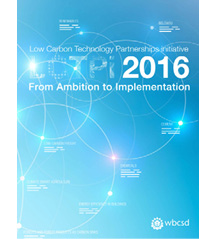Members of the Cement Sustainability Initiative (CSI) under the Geneva-based World Business Council for Sustainable Development (WBCSD) concur with formal adoption of the United Nations-crafted Paris Agreement, under which signatory countries pursue long-term greenhouse gas emissions reduction measures. A threshold crossed earlier this fall—where more than 50 percent of signatories took official action toward commitments affirmed at the December 2015 Conference of Parties in Paris—triggered last month’s commencement of GHG management protocols.
|
|
| Posted at www.wbcsd.org, the new Low Carbon Technology Partnership Initiatives report shares first year results from 165 participating companies in eight working groups defined by business sector or mission—cement and energy efficiency in buildings among them. Leading the charge in the former is LafargeHolcim Ltd. |
“The cement sector has been working collectively since 1999 on measuring and reporting its CO2 emissions while developing solutions for mitigation and adaptation through the [Initiative],” says CSI and Cemex S.A.B. de C.V. Chairman Fernando Gonzalez. “We welcome the entry into force of the Paris Agreement that sets the long awaited regulatory framework to scale-up the implementation of these solutions and encourages further cooperation between private companies, policy makers and the financial community.”
“The agreement sets a framework for reporting CO2 emissions that looks fully compatible with what the CSI has developed 10 years ago, including the independent verification,” adds CSI Managing Director Philippe Fonta.
Cemex, Argos, CRH, GCC, HeidelbergCement, Titan, Votorantim Cimentos and fellow CSI members developed a common energy and CO2 emissions reporting method based on WBCSD- and World Resources Institute-referenced greenhouse gas protocol. Initiative members follow the common methodology in their reporting to a centralized database dubbed Getting the Numbers Right; managed by an independent third party for antitrust considerations, it represents the most comprehensive CO2 emissions database to date of any single industrial sector. The trend across a decade of CSI member reporting demonstrates the industry’s continuous CO2 emissions reduction.
Getting the Numbers Right provides a baseline of emissions to inform low-carbon technology roadmaps, including one developed by CSI in partnership with the International Energy Agency, plus future market mechanisms tied to the Paris Agreement. CSI is now working on extending tools and guidelines to additional cement companies to build on members’ leading initiatives and scale up implementation of current carbon reduction solutions. Global adoption of CSI targets and measures could see the cement sector cut total CO2 emissions 20-25 percent by 2030. That reduction would represent upward of 1 gigaton, equivalent to the annual emissions of a country like Germany.
CSI members convene this month in Madrid for its annual forum to share achievements the cement sector reached in the first year after the Paris agreement was adopted and weigh the next milestones of a global action plan covering energy efficiency; use of alternative fuels; reducing clinker-to-cement ratios; identifying and measuring the avoided emissions throughout the value chain by using sustainable concrete; development of new cements and concrete; plus, carbon capture and utilization or storage opportunities.
